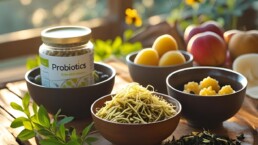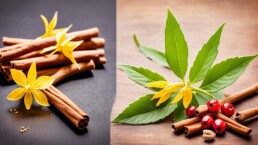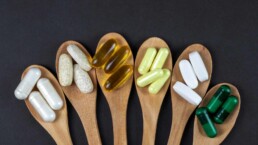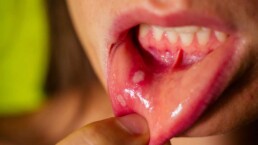Knee pain is a common issue that can really slow you down. It’s often caused by wear and tear, overuse, injury, or conditions like arthritis. Luckily, there are many home remedies that can help. These include physical activity, posture support, managing your weight, using medication, getting a massage, trying aromatherapy, and using heat and cold therapy.
Table of Contents
ToggleThese holistic methods can make moving easier and help with knee pain. They offer a way to feel better without just taking medicine.
Key Takeaways
- Home remedies can effectively manage knee pain and joint discomfort
- Physical activity, such as walking, cycling, and Tai Chi, can strengthen the knee joint
- Posture support and weight management can minimize strain on the knees
- Natural therapies like massage, essential oils, and the PRICE method can provide relief
- Alternating heat and cold therapy can help reduce inflammation and improve joint function
Physical Activity: Exercises to Strengthen the Knee Joint
Regular physical activity is key to managing knee pain and making the joint stronger. The American College of Rheumatology and Arthritis Foundation suggest low-impact activities. These can help keep your knees healthy and slow down osteoarthritis.
Walking, Cycling, Swimming, Tai Chi, and Yoga
Exercises like walking, cycling, swimming, tai chi, and yoga are great for your knees. They boost flexibility, motion, and muscle strength around the knee without putting too much stress on it. Adding these activities to your daily routine can support your knee health.
Strengthening the Quadriceps Muscles
Strengthening the quadriceps muscles at the front of your thigh helps protect your knee joint. Leg raises and step-ups are good exercises for these muscles. They are crucial for stabilizing and supporting the knee. Adding these exercises to your routine can improve your knee’s strength and function.
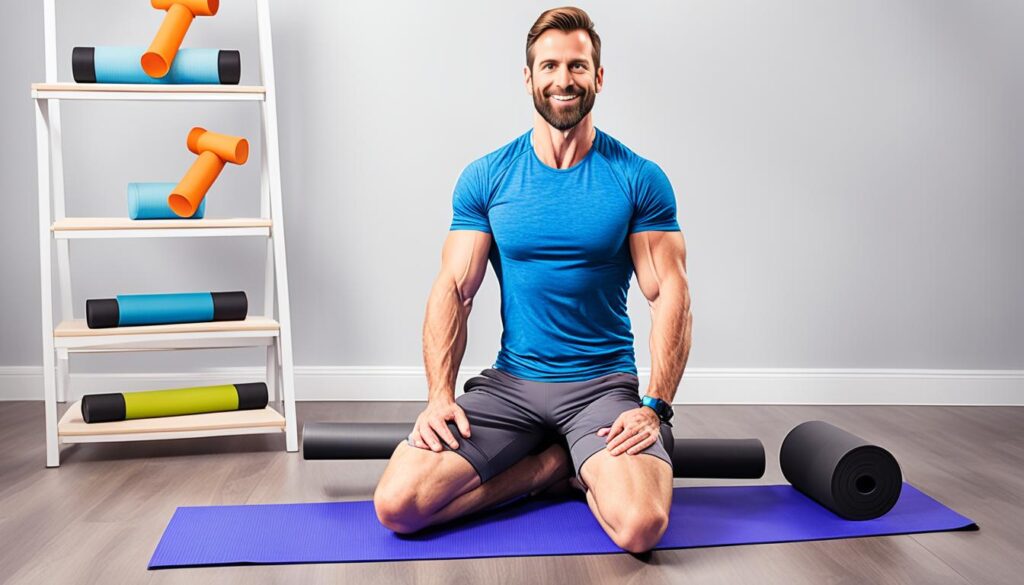
Always talk to a healthcare professional before starting new exercises, especially if you have knee pain or discomfort. They can give you advice and help create a safe and effective exercise plan for your needs.
Posture and Support: Minimizing Knee Strain
Keeping your knees in the right position and using support can help reduce pain. Avoid low chairs and couches, wear supportive shoes, and don’t sit for too long. These steps can help protect your knees and ease pain.
Avoiding Low Chairs and Couches
Sitting in low chairs or couches can strain your knees. It makes your legs bend in an awkward way. Choose chairs and sofas that support your knees well. Use a small pillow or cushion if you need to.
Wearing Supportive Shoes
The right shoes can greatly help with knee health. Look for shoes with good arch support, cushioning, and a strong sole. Stay away from flat, unsupportive shoes as they can cause knee pain.
Avoiding Prolonged Sitting
Sitting for a long time can stress your knees. Try to stand up and stretch regularly. If you sit a lot at work, think about using a standing desk or taking short walks.

By focusing on your knee posture, using support, and not sitting too long, you can reduce knee strain. These simple steps can help keep your knees healthy and working well.
Weight Management and Diet: Mediterranean-Style Eating
Keeping a healthy weight is key to easing knee pain. Carrying extra weight puts more stress on your joints, making pain worse. The Arthritis Foundation suggests a Mediterranean-style diet to help manage weight and ease knee pain.
This diet focuses on plant-based foods like fruits, veggies, whole grains, legumes, and healthy fats. It’s great for losing weight and has anti-inflammatory effects that can lessen knee joint inflammation.

- Olive oil as the primary source of fat
- Nuts and seeds, such as almonds, walnuts, and chia seeds
- Fatty fish, like salmon, mackerel, and sardines, which are rich in omega-3 fatty acids
- Whole grains, including quinoa, brown rice, and whole-wheat bread
- Plenty of fresh fruits and vegetables
- Legumes, such as lentils, chickpeas, and beans
By eating like the Mediterranean diet, you can help with weight loss, reduce inflammation, and ease knee pain. This way of eating is a strong tool for better joint health.
Medications: NSAIDs, Topical Creams, and Injections
Managing knee pain can be helped by medications. There are both over-the-counter and prescription options. Each has its own benefits and things to consider.
NSAIDs like ibuprofen or naproxen can lessen inflammation and ease knee pain. You can take these medications by mouth or use topical creams and gels. Topical creams with capsaicin can also help with pain in a specific area.
For really bad or ongoing knee pain, steroid injections might be an option. These injections can cut down on inflammation and make the pain less. But, they are usually saved for when other treatments haven’t worked well enough.
It’s key to know that while tramadol can be used for knee pain, it’s not often the first choice. This is because of the risk of becoming addicted and other side effects. Always talk to your doctor to find out what’s best for you.
- NSAIDs, both oral and topical, can help reduce inflammation and ease knee pain
- Topical creams containing capsaicin may provide localized pain relief
- Steroid injections can be an option for severe or persistent knee pain
- Opioid medications are generally not recommended as a first-line treatment for knee pain
Massage: Self-Massage Techniques for Knee Relief
If you’re dealing with ongoing knee pain, self-massage might help. It can ease the muscles around the knee, boost blood flow, and lessen pain.
The American Massage Therapy Association suggests some easy self-massage exercises for home:
- Tapping the thigh: Gently tap the skin over the front of your thigh, moving downward toward the knee. This can help stimulate the nerves and increase blood flow.
- Gliding the hand: Slowly glide your hand down the front of your thigh, over the knee, and back up. This can help soothe and relax the muscles.
- Pressing into the knee: Use your fingertips to apply gentle pressure to the tissue around the knee. Avoid pressing directly on the kneecap. This can help release tension in the joint.
Always be gentle and skip any moves that cause sharp pain. Regular knee massage and self-massage can be a key part of managing knee pain. Combine it with other methods like exercise and weight control.
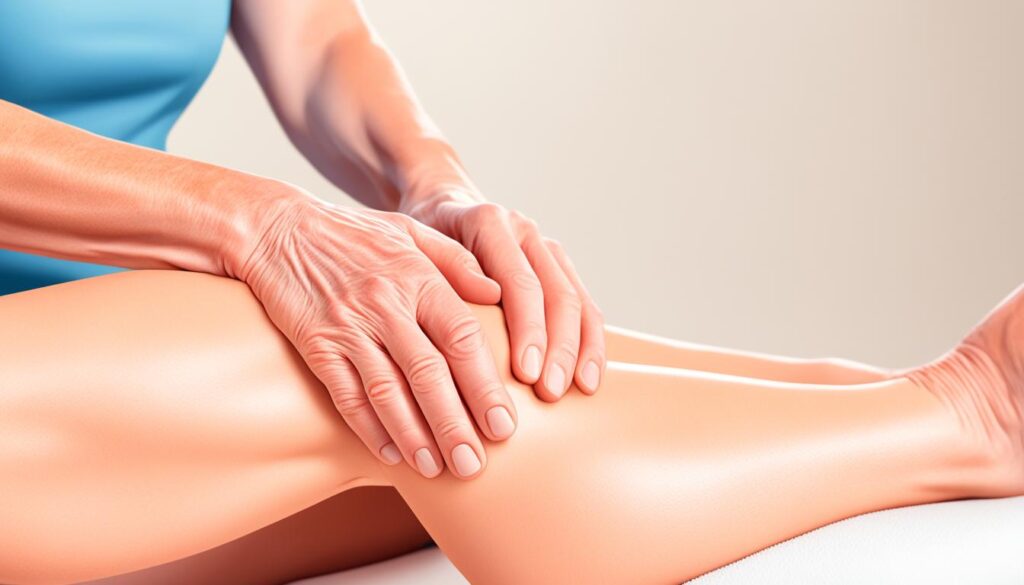
Adding these easy thigh massage steps to your daily routine can help you take charge of your knee pain. It also supports your overall joint health.
Aromatherapy: Essential Oils for Pain and Function
If you’re looking for natural ways to ease your knee pain, essential oils might be an option. Studies show that oils like ginger and cinnamon can help reduce knee pain and make joints work better.
Aromatherapy uses essential oils for health benefits. These oils come from plants and can be used on the skin or breathed in. They might help with knee pain because they reduce swelling and ease pain.
When using essential oils for knee pain, mix them with a carrier oil first. This keeps your skin safe from irritation. You can also add a few drops to a warm bath or use a diffuser to breathe them in.
- Consider trying essential oils like bergamot, black cumin, cinnamon, or eucalyptus to help alleviate knee pain and discomfort.
- Always conduct a patch test before using a new essential oil to check for any allergic reactions.
- Consult with your healthcare provider, especially if you have any underlying medical conditions or are pregnant, before incorporating essential oils into your knee pain management routine.
Looking into aromatherapy and essential oils could be a good way to help with knee pain and improve joint function. But, always be careful and talk to a professional to make sure you’re using these oils safely and effectively.

PRICE: Protection, Rest, Ice, Compression, and Elevation
If you’ve had a knee injury, like a sprain or inflammation, the RICE method can help. RICE means Protection, Rest, Ice, Compression, and Elevation. It’s a good way to ease mild knee pain and swelling.
The RICE method tackles the main causes of knee pain after an injury. Here’s how each step helps:
- Protection: Use crutches, braces, or other devices to keep your knee safe. This limits movement and prevents more injury.
- Rest: Let your knee rest and avoid activities that make it worse. Try not to put weight on the injured leg.
- Ice: Use cold packs or compresses on your knee for 15-20 minutes, several times a day. It helps reduce swelling and pain.
- Compression: Wrap your knee with an elastic bandage or sleeve. This gives support and helps control swelling.
- Elevation: Keep your knee higher than your heart when you can. It helps drain fluid and lessen swelling.
Following the RICE method helps you manage your knee injury or inflammation. It supports healing. Always talk to a healthcare professional if your symptoms don’t get better or get worse.
home remedies for knee pain: Natural Therapies
Natural remedies can help with knee pain alongside traditional treatments. They offer a different way to tackle pain. We’ve talked about physical activity, posture, and diet. Now, let’s look at a few more natural therapies.
Willow bark extract is one option. It has a compound like aspirin that can lessen inflammation and ease pain. Ginger supplements also have anti-inflammatory effects that can help the knee joints. Some people find acupuncture helpful by boosting the body’s natural pain relief.
But, always talk to your doctor before trying new supplements or therapies. They might not mix well with your current medicines or could have side effects. It’s important to use a mix of methods that suit you best.
Dealing with knee pain often means using many approaches. By trying natural remedies along with other methods, you can help ease your pain. This can improve your life quality too.
Heat and Cold Therapy: Alternating for Joint Relief
Using heat and cold therapy can help with knee pain. Switching between these methods helps tackle different symptoms of knee pain.
Harnessing the Power of Heat Therapy
Heat therapy relaxes muscles and helps with joint lubrication. You can use a heating pad or take a warm bath. This increases blood flow, aids healing, and reduces stiffness. Just remember, use heat for 20 minutes at a time to prevent skin issues.
The Benefits of Cold Therapy
Cold therapy is great in the first 24 hours after an injury. It reduces swelling and inflammation, easing pain. Just make sure to wrap ice in a towel before applying it to your skin.
Alternating Hot and Cold Treatments
- Start with a cold pack for 10-15 minutes to reduce swelling and inflammation.
- Then, use a warm heating pad or soak in hot water for 15-20 minutes to boost blood flow and relax muscles.
- Keep alternating between heat and cold several times a day.
Using both heat therapy and cold therapy helps with knee pain relief and joint health. Always be careful and avoid extreme temperatures to prevent injury.
Conclusion: Exploring Natural Options for Knee Pain Management
Many people can ease knee pain with home remedies and natural therapies. By adding physical activity, posture support, and managing weight, you can help your knees. Also, using medications, massage, aromatherapy, the PRICE method, and heat or cold therapy can make a big difference.
Trying these natural knee pain solutions can help you manage your pain in a full way. From doing exercises to using essential oils, there are many ways to ease joint pain and get moving again.
By focusing on your knee health from all angles, you can take back control and feel better every day. Everyone is different, so it’s important to try various natural remedies to see what works best for you.
FAQ
What are some common causes of knee pain?
Knee pain is common, especially as people get older. It can come from joint wear, overuse, injury, or conditions like arthritis.
What are some home remedies for managing knee pain?
Home remedies can ease knee pain. Try physical activity, posture support, and managing your weight. Also, use medications, massage, aromatherapy, the PRICE method, and heat and cold therapy.
How can exercise help with knee pain?
Exercise is key for knee pain relief. The American College of Rheumatology and Arthritis Foundation suggest walking, cycling, swimming, tai chi, and yoga. These activities improve joint health and slow down osteoarthritis. Strengthening muscles around the knee with exercises like leg raises and step-ups also helps.
How can proper posture and support help reduce knee pain?
Good posture and support ease knee strain. Avoid low chairs and use a pillow to raise your seat. Keep good sitting posture, wear supportive shoes, and limit sitting to reduce knee pain.
How can weight management and diet impact knee pain?
Carrying extra weight adds pressure on your knees. Managing your weight is key to reducing pain. The Arthritis Foundation suggests eating a Mediterranean-style diet. This diet is full of fruits, veggies, and fiber but low in meat and animal fat. It helps keep you at a healthy weight and lowers inflammation.
What medications can help manage knee pain?
Over-the-counter and prescription drugs can ease knee pain. Options include oral or topical NSAIDs, creams with capsaicin, and steroid injections. But, opioids are not usually recommended for knee pain, except for tramadol.
How can massage help with knee pain relief?
Massage can soothe knee pain. The American Massage Therapy Association suggests tapping the thigh, gliding the hand down the thigh, and pressing on the knee. These techniques can help manage discomfort.
Can essential oils and aromatherapy help with knee pain?
Some essential oils, like ginger and cinnamon, might lessen knee pain and improve joint function. Using these oils can offer a natural way to find relief.
What is the PRICE method for treating knee pain?
The PRICE method stands for protection, rest, ice, compression, and elevation. It’s a good approach for mild knee pain from injuries like sprains. Protecting the knee, resting it, icing it, compressing it, and elevating it can cut down swelling, inflammation, and pain.
What other natural therapies can help manage knee pain?
Other natural therapies for knee pain include willow bark extract, ginger supplements, and acupuncture. Always talk to a healthcare provider before trying new supplements or treatments.
How can heat and cold therapy help with knee pain?
Heat and cold therapy can ease knee pain. Heat relaxes muscles and helps with joint lubrication, while cold reduces inflammation and swelling. Alternate between heat and cold, using heat for up to 20 minutes and cold more often in the first 24 hours after an injury. Use heat and cold correctly to avoid skin issues.
Source Links

This article is medically reviewed by Dr. Chandril Chugh, Board-Certified Neurologist, providing expert insights and reliable health information.
Dr. Chandril Chugh is a U.S.-trained neurologist with over a decade of experience. Known for his compassionate care, he specializes in treating neurological conditions such as migraines, epilepsy, and Parkinson’s disease. Dr. Chugh is highly regarded for his patient-centered approach and dedication to providing personalized care.

